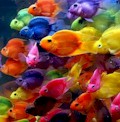Disease in the aquarium is often the result of poor environmental conditions, as this weakens the fish and makes them susceptible to disease. Here we describe four common ailments suffered and suggested treatments for fish lice, fungus, gill flukes and hole-in-the-head.
Fish LiceSymptoms: Behavior wise you will see the fish trying to scratch itself against whatever it can find. You will also see round shaped transparent parasites stuck to the fishes body. Evidence of locations the parasite has visited previously will show as red patches or areas that are scarred.
Reason: These parasites, that have eight legs, are lice (Argulus) that attach themselves by suckers, break the skin and feed on the fish. Eggs are laid away from the fish. Some say that they are often mistaken for algae but if you look closely enough you'll see what they are if they are adult as they appear a green color but the young may not be so obvious.
Treatment: The adult parasites can be removed by tweezers once the fish has been removed from the aquarium. Treat the affected area with an antiseptic. Then you could use a tank wide treatment to deal with the younger and newly hatched parasites with an organophosphate such as Dimlin (Diflubenzuron) but this sort of chemical is now banned in many countries.
I have noted that Parazin P, a medication suitable for treating crustacean infestations, has been proposed and takes several weeks to take effect as it is based on the life cycle of the parasite.
I have also read of a treatment whereby the fish is rubbed with a piece of kitchen roll paper on the parasite affected area, the fish is dipped in water (at the same temperature of the main tank) and all the parasites in that area leave the fish! Apparently the parasites do not like dry conditions, hence the use of the dry paper roll. It cannot do any harm so why not try it?
FungusSymptoms: The areas of the body that are affected are those where the mucous layer that protects the skin has been damaged. You will see cotton wool like material attached to the fish or the whole appearance of the skin may seem unclean. This is why this disease is often referred to as the cotton wool disease. Fungus types are typically Saprolegnia, Achlya, Leptomitus and Pythium.
Reason: This is a secondary infection as it often occurs after an initial wound has happened or where a parasite has been active or after the fish has suffered from white spot. Could also be due to bad water quality.
Treatment: You can use a proprietary fungicide such as phenoxyethanol to treat the individual fish in a hospital/quarantine tank but try to determine the cause of the outbreak and put corrective measures in place, otherwise it may well break out again. Salt baths are another alternative or the use of Gentian Violet topically on the affected area.
Gill Flukes (Dactylogyrus)Symptoms: You will see the fish rubbing itself against objects to relieve the itching. It may be breathing fast or gulping for oxygen at the surface. As the disease takes hold the fish will become lethargic and try to isolate itself in a corner or stay on the bottom of the tank. It will go off its food, have swollen gills and a gill may be kept open or kept closed.
Reason: A worm like parasite up to 2 mm long infests the gills of the fish and reproduces there. It has hooks on its body to dig into the flesh which causes damage and possible bacterial infection. But the main effect is to reduce the fish's ability to breathe and get in enough oxygen, eventually leading to death.
Treatment: This is an infectious disease so treatment of all fish is recommended. As the parasites eggs are quite hardy, repeated treatments over a few weeks will be needed to kill off the newly hatched worms. Fluke tabs are no longer recommended.
Praziquantel (Droncit (USA) or Drontal (UK) are preferred as they are safer for the fish. Other UK treatments include Paragon (for mild infections and safe with shrimps and snails or Sterazin (for serious infections but not safe with shrimps and snails. A follow up bacterial treatment is probably advisable to counteract any secondary infection caused by the parasite.
Hole in the Head (Hexamitiasis)Symptoms: This disease has an effect on the insides of the fish (intestines) and the skin (under it) so you might see pits in its head and its feces will appear to be thready and white. Discus fish are particularly susceptible. The fish may swim backwards, it might look for shelter with its head facing downwards and the usual color will become darker.
Reason: A parasite called Hexamita is the culprit. It lives in the intestines and can become a problem when fish become stressed and/or weak due to poor environmental conditions.
Treatment: Metronidazole at about 500 mg per 10 gallons is the normal dosage. Dissolve the medication in hot water first. Several treatments may be needed over two weeks with 50 percent water changes carried out before each treatment. I have noted that some folk add Malachite Green to act on secondary infections.
Putting medication in the fish's food is a good idea because the disease has an effect on the fish's insides. 250mg (0.25g) of Metronidazole in 25g of food will do the trick.

